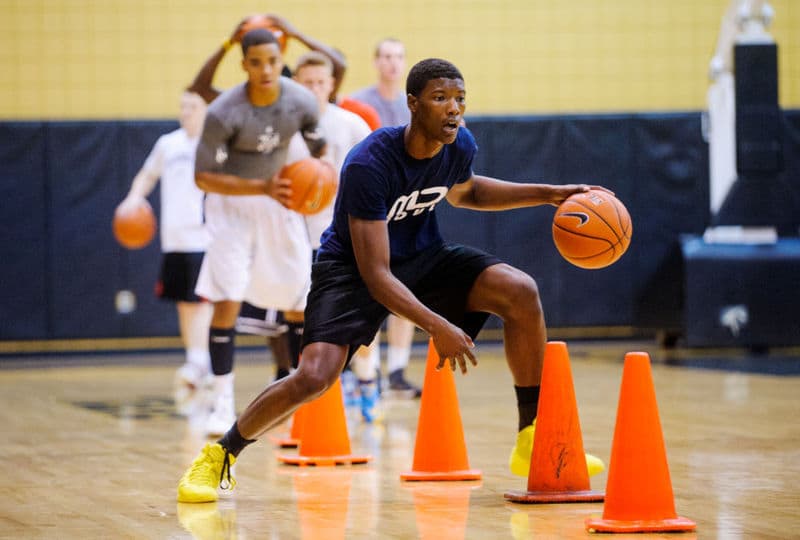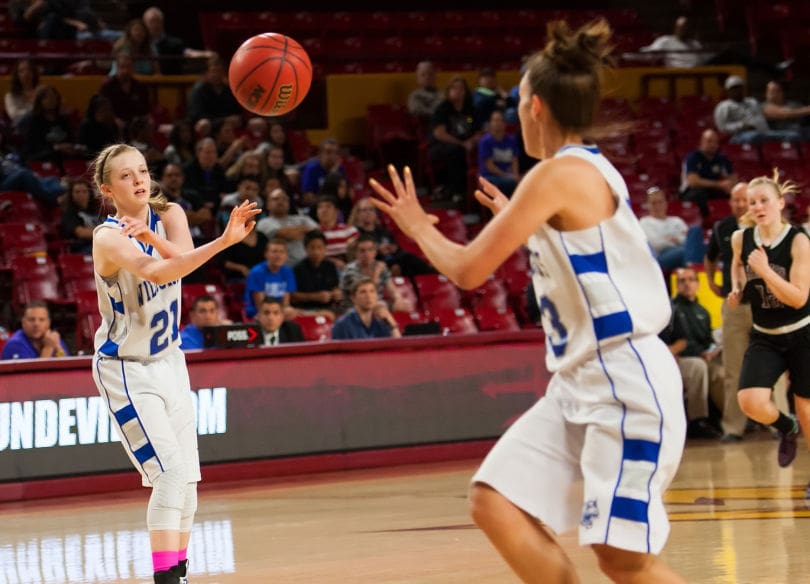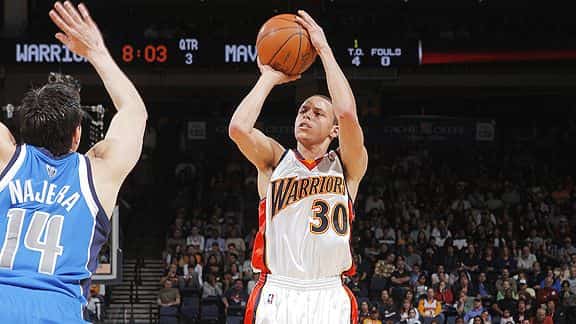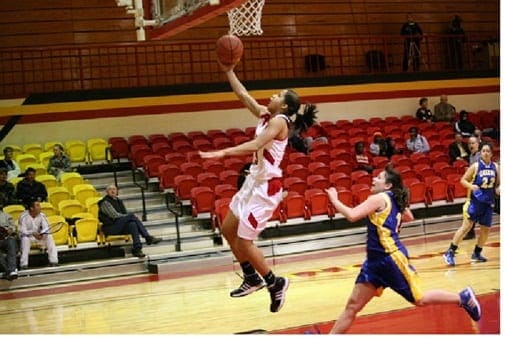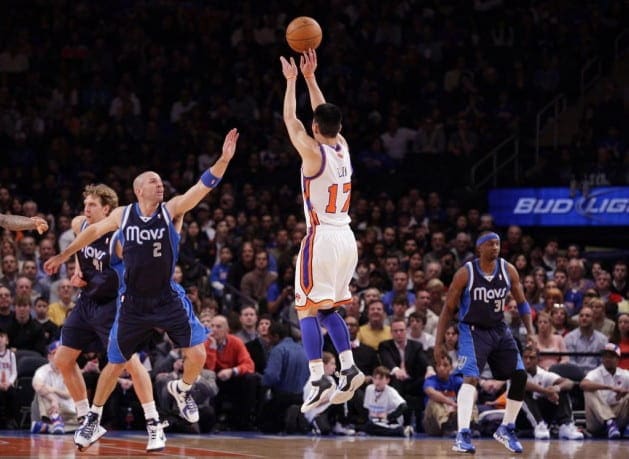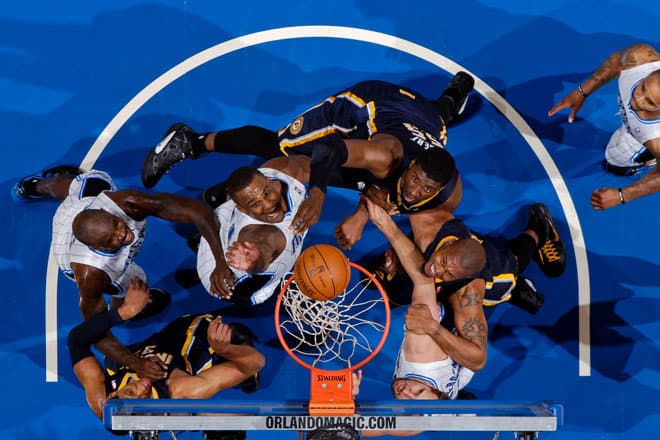Introduction: Basketball Rules and Fundamentals
In Basketball Rules and Fundamentals o Physical Education Tips presents 10 Basic Basketball Rules and the main Basketball Technical Fundamentals. Good reading!
01 – How big is the basketball court?
According to the Basketball Rules, a basketball court is 28 meters long by 15 meters wide.
- See details about the Basketball Court in the post: THE OFFICIAL BASKETBALL COURT: LINES, MEASUREMENTS AND MARKINGS
02 – HOW HIGH IS THE BASKETBALL HOOP?
- The Basketball Basket (hoop) is 3.05 meters off the ground
- The basketball court is 2.90 meters above the ground
- The diameter of the basketball hoop is 45 centimeters.
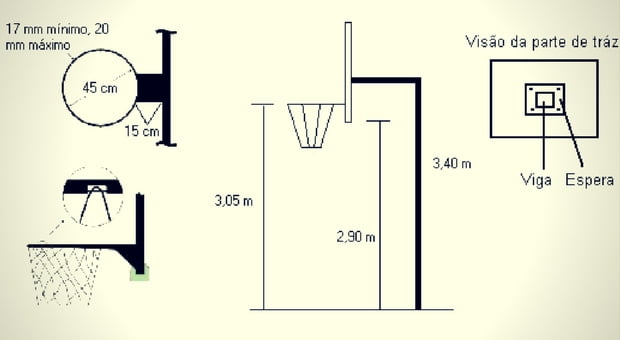
03 – HOW MANY PLAYERS MAKE UP A BASKETBALL TEAM?
-
A basketball team is made up of a maximum of 12 players, with 5 on the court and up to 7 reserves.
-
A coach, an assistant coach and up to 5 members of the coaching staff
04 – HOW LONG DOES A BASKETBALL MATCH LAST?
A basketball match is divided into 4 periods of 10 minutes each. If at the end of the last quarter the game is tied, there will be a 5-minute overtime and as many as necessary until the game has a winner.
05 – BALL HANDLING IN BASKETBALL
During the game of basketball, the ball can only be touched with the hands. It can be passed, rolled, thrown or bounced.
Basketball is not allowed:
-
Running with the ball
-
Kicking the ball
-
Hit the ball with your fist
-
Intentionally intercepting the ball with any part of the leg
“ Unintentionally touching the ball with your leg is not a violation of the rule.”
06 – HOW MANY POINTS IS A BASKET WORTH IN BASKETBALL?
- A free-throw basket is worth 01 point
- A converted basket in the area bounded by the three-point line is worth 02 points
- A converted basket outside the 3-point line is worth 03 points
07 – BALL REPLACEMENT IN BASKETBALL
Ball replacement in basketball is done outside the boundary lines of the court and in the place closest to where the infraction occurred. The referee must give the ball to the player who is going to replace it. The player will have 5 seconds to make the rebound.
08 – VIOLATIONS OF BASKETBALL RULES
Whenever there is a violation of the rules of basketball, the ball must be awarded to the opponent for replay outside the court from the place closest to where the violation occurred.

Types of violations (infractions) of basketball rules:
- Player or ball out of court (player or ball is considered out of court when it comes into contact with the ground, object or person outside the court)
- Player dribbles twice in a row
- Player walking with the ball
- Player remains more than 3 seconds inside the opponent’s restricted area (Garrafão) when his team has possession of the ball
- Player holds the ball for more than 5 seconds
- Remaining in possession of the ball for more than 8 seconds on the court defense
- Not making a shot at the opponent’s basket within the 24-second time limit
- Return the ball from the attacking court to the defending court
“A player in the defense zone may not interfere with an opponent’s shot that is on a downward trajectory, nor touch the rim or the basket, if this occurs, a point will be awarded to the opposing team according to the position or situation in which the shot was taken.”
09 – FOULS IN BASKETBALL
Fouls are infractions of the rules of basketball relating to physical contact or an unsportsmanlike attitude.
LEGAL DEFENSE POSITION
A player is in a legal defensive position when he is facing his opponent, with his feet on the ground and occupying a cylindrical space.
It’s considered a foul in basketball:
- Causes contact with an opponent who is in a legal defensive position (attacking foul)
- Blocking or obstructing an opponent from their legal defensive position
- Charging(pushing) the opponent
- Touching the opponent with your hands, restricting their movements
- Grabbing the opponent anywhere on the body
10 – TYPES OF FOULS IN BASKETBALL

- Personal foul: illegal physical contact with the opponent
- Double foul: this is when two opposing players commit a personal foul at the same time. The foul will be noted by the table and the game will restart normally without any penalty for the teams.
- Technical foul: is marked by inappropriate behavior on the part of the team’s players or coaching staff.
- A player who commits two technical fouls will be disqualified from the game
- If a technical foul is committed by a player, it counts as both an individual and a team foul
- If committed by a member of the bank, it will not count as a collective fault
- The opposing team will be awarded a free throw plus ball replacement
- Unsportsmanlike Foul: is an intentional foul that violates the spirit of the rules of the game.
- A player who commits two unsportsmanlike fouls will be disqualified from the game
- free throws will be awarded to the opposing team.
- If the foul was committed on a player who was not shooting, the team is entitled to 2 free throws.
- If the foul was committed on a player who was in the act of shooting, the shot will be converted and the team will have 1 more free throw.
- Disqualifying Foul: is an explicitly unsportsmanlike foul.
- The player will be disqualified
- If the foul was committed on a player who was not in the act of shooting, the team will be entitled to 2 free throws plus ball replacement
- If the foul is non-contact: 2 free throws
- If a foul is committed on a player in the act of shooting: the basket is converted and, in addition, 1 free throw.
- If a foul is committed on a player in the act of shooting and the basket is not converted: 2 or 3 free throws depending on the position of the shot.
“According to the Rules of Basketball if a player commits 5 fouls he must be informed by a referee and must leave thegame immediately. He must be substituted within 30 seconds.”

VIDEO ABOUT BASKETBALL’S BASIC RULES
For those of you who like video content, Dicas Educação Física recommends the following video >> Rules of the Game: Basketball.
The Technical Fundamentals of Basketball
Body Control in Basketball
Body Control or Body Handling is very important for performing basketball movements. Body control is important in both defensive and attacking movements and should not be overlooked in introductory basketball classes.
Some Body Control movements that should be practiced in basketball are:
- Cute
- Fintas
- Races with multiple changes of direction
- Front running, back running and side running
- Sudden stops (stopping abruptly after a run to make it more difficult for the opposition to score)
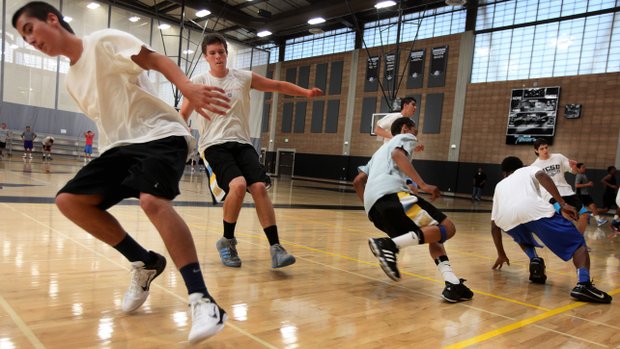
Ball Handling in Basketball
Ball Handling is the Basketball Fundamentals that aims to develop the ability to Control the Ball in different situations.
Some Ball Handling movements that should be practiced in Basketball are:
- Roll the ball
- Bounce the ball
- Holding the ball
- Changing hands
- Throw the ball from one side of the body to the other over the head
- Throw the ball from the back to the front of the body over the head
- Throwing or passing the ball between the legs
- Pass the ball around your body (at knee height and waist height)
To see more examples of ball handling in basketball, watch the video by Prof. Santiago Reais from the Basketball Channel Góias E. C. ⇒ Ball Handling – Basketball Training
Dribbling in Basketball
Dribbling is one of the most used basketball fundamentals during a game, the act of bouncing the ball with one hand. Dribbling is used so that the basketball player can move with possession of the ball.
A simple tip that should always be observed when dribbling is that the dribbling player should always keep the opposite leg of the dribbling hand forward:
- Dribble with your right hand, left leg in front.
- Dribble with your left hand, right leg in front.
What are the types of dribbling in basketball?
1 – High Dribble ⇒ Also called the Speed Dribble, because it is used when the basketball player is unmarked and can move at speed. In the High Dribble, the ball is propelled further ahead of the body.
2 – The Low Dribble ⇒ Also called the Protection Dribble, because this type of dribble is used when there is a marker close to the player who has the ball, so he needs to dribble to protect the ball from his marker. In this type of dribbling, the legs bend more and the ball is always protected by the player’s body.
Tips for dribbling
- Always dribble with your head up (looking at your marker and the movement of the other players)
- Dribble by pushing the ball down (don’t hit the ball)
- During the dribble, don’t let the ball rise beyond waist height
What is Dribbling for?
- To get rid of a marker
- To adjust the body position for a throw or pass
- To protect the ball in front of a marker
- To move at speed with the ball
Basketball Fundamentals: Passing
Passing in basketball is the act of throwing the ball to a player on the same team. It is an attacking skill used to move the team.
What are the types of passes in basketball?
1 – The Chest Pass ⇒ The Chest Pass is the most common type of pass in Basketball, it is a pass for short and medium distances, it is a quick pass and the ball follows a straight trajectory.
2 – The Chopped Pass ⇒ The Chopped Pass in basketball is used over short distances. In this type of pass, the ball touches the ground before reaching the teammate.
3 – The Overhead Pass ⇒ The Overhead Pass in Basketball is performed over short distances, throwing the ball over the marker.
4 – The Shoulder Pass ⇒ The shoulder pass in basketball is used to reach long distances. It is often used in counter-attacking plays, when you want to make a long pass to catch the opponent’s defense off guard.
“Unlike handball, the shoulder pass in basketball is made with both hands.”
5 – The Hook Pass ⇒ The hook pass in basketball is used over long distances and is a type of pass with little precision.
Basketball Fundamentals: Shooting
Shooting in basketball is an attacking action aimed at making a basket (points).
What are the types of shots in basketball?
1 – One-handed shot ⇒ This is the most common type of shot in basketball. It is made by placing the main hand under the ball and the other hand on the side for support. The ball must be thrown into the basket using only the hand that is under the ball. The one-handed shot can also be made with a jump shot.
Tips for executing the one-handed throw:
-
If you throw with your right hand, your right leg should be slightly forward, the same goes for throwing with your left hand
-
Bend your legs a little at the start of the throw
-
The elbow of the throwing hand should be pointing towards the basket.
-
Look at the basket
-
Flex the wrist at the end of the throw
-
Throw ball on a parabolic trajectory
Basketball Tray Throw
The Tray is one of the most common basketball fundamentals. It is a type of shot made on the move, close to the basket and with a jump.
What Are the Types of Trays in Basketball?
Tray with possession ⇒ This is when the player comes dribbling, approaches the basket, holds the ball, takes two steps and jumps towards the basket, shooting the ball.
Tray without possession ⇒ This is when the player receives the ball near the basket and makes the Tray without dribbling.
The Jump Fundamentals of Basketball
The jump shot is a type of basketball shot made with a jump. The Jump can be made while moving or standing still and the ball must be thrown at the moment the player reaches the highest height in the jump.
Basketball rebounding fundamentals
Rebounding in basketball is the act of catching the ball after an unconverted shot.
What are the types of rebounds in basketball?
Defensive rebound ⇒ Also called a defensive rebound, this is when a player from the defending team takes the rebound after an unconverted shot from the opposing team.
Offensive Rebound ⇒ Also called an Attack Rebound, this is when a player from the attacking team takes the Rebound after an unconverted Throw-in from their own team.




